Miami tourism visitor numbers in 2025 highlight the city’s continued appeal as one of America’s top travel destinations, attracting millions from around the world.
Despite slight shifts in international arrivals, Miami remains a hotspot for leisure, culture and events that drive strong visitor growth year-round.
Miami Tourism at a Glance in 2025
Miami-Dade County, including Miami Beach, remains one of the nation’s leading travel destinations, with tourism accounting for about 9% of the county’s GDP in 2024 and supporting more than 209,000 jobs.
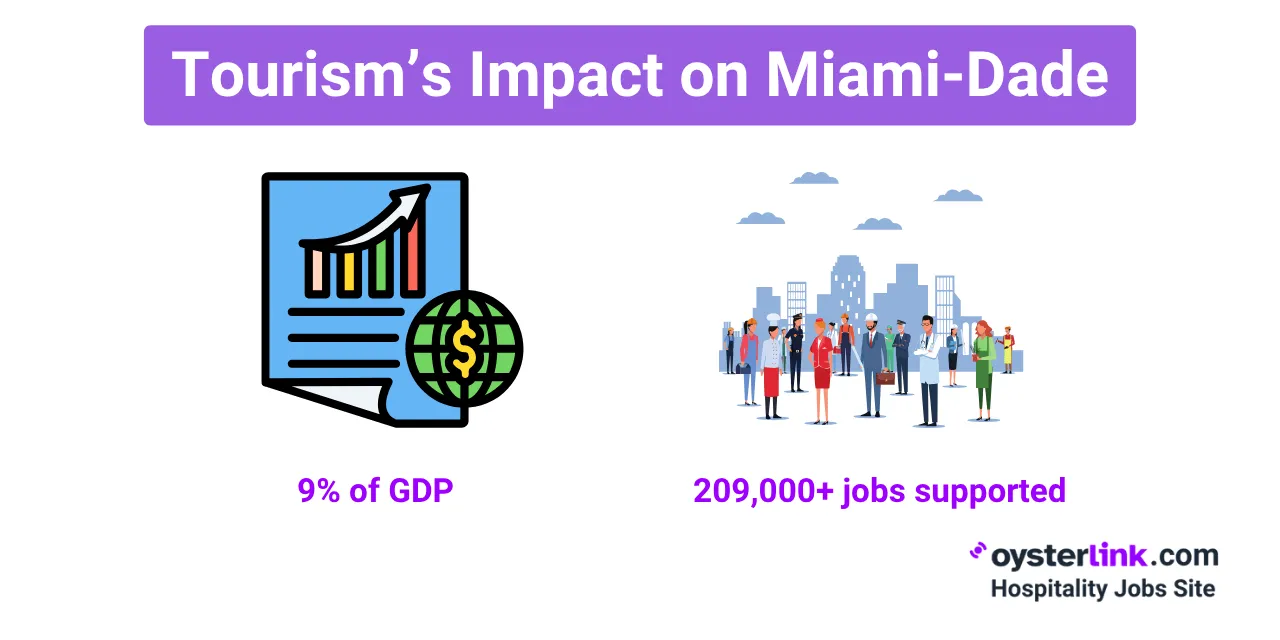
While full-year 2025 data are still being compiled, early indicators show strong domestic demand but some softness in international arrivals, particularly in the first quarter.
Miami Tourism Visitor Numbers in 2025 and Total Visitor Spending
In 2024, Miami-Dade reached a milestone with 28.23 million visitors.
These visitors generated approximately $22 billion in direct spending with total economic impact estimates of $31 billion for the county.
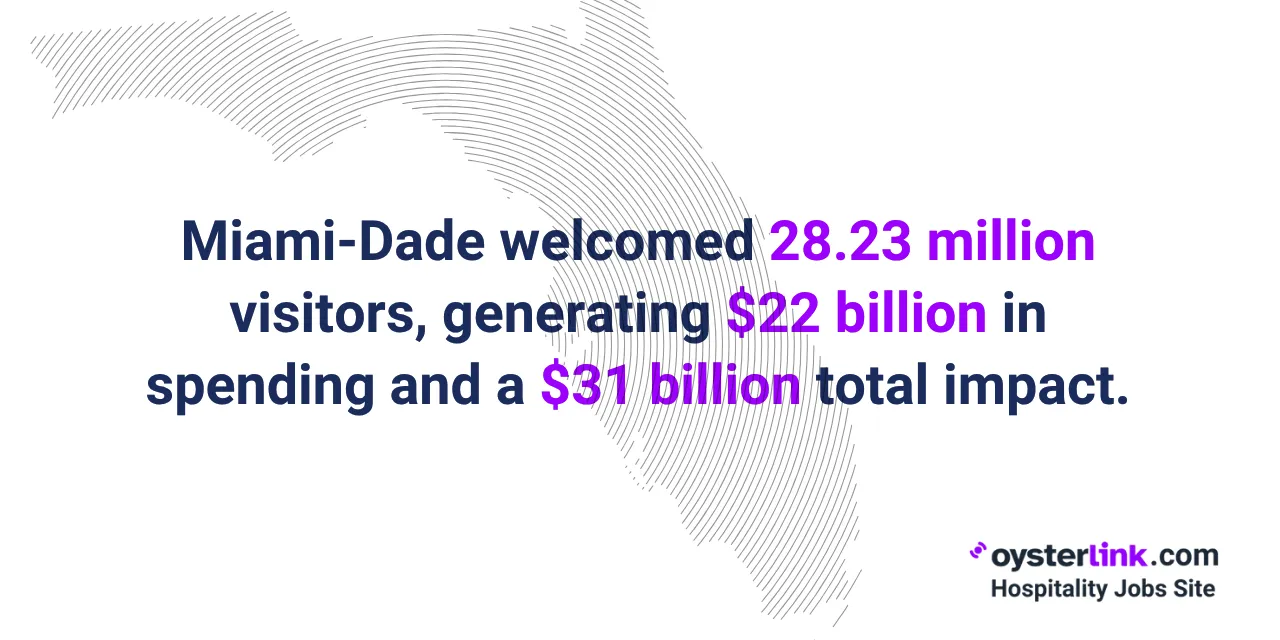
The 2025 outlook remains positive, though several global and industry factors may slow growth slightly.
According to WLRN, Miami remains a strong destination for both leisure and business travel, but a range of external pressures is moderating performance:
- Global economic slowdown: A slowing global economy is reducing discretionary travel budgets, particularly among international visitors. When economies in origin markets tighten, people are less likely to travel abroad.
- Trade, immigration and regulatory uncertainty: Changes in trade policy, immigration enforcement and visa processing can deter international travel or make it more complicated, thus cutting into anticipated visitor volumes.
- Declining arrivals from some source markets: For example, Canadian visitation to Miami-Dade fell by 4% last year. These region-specific drops suggest that the broad “international guest” segment is vulnerable.
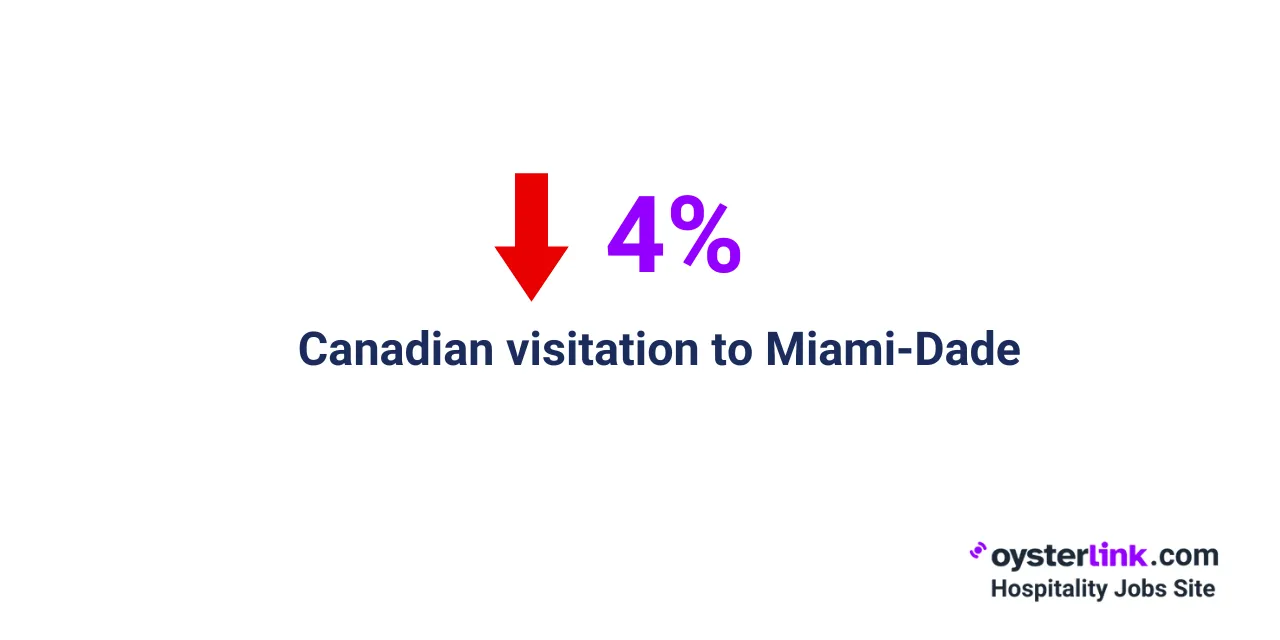
- Hotel and accommodation supply growth: New hotel openings and increasing room inventory can push down room rates or occupancy if demand growth doesn’t keep pace, making it tougher for tourism revenue to rise even if visitor counts hold steady.
See more industry data in the U.S. Hospitality Industry Statistics Report
- Short-term softness in business/events travel: Industry leaders note that “a lot of the business events are postponing their meetings” due to uncertainty. This directly affects convention and business travel revenue, which supports hotels and local services.
For hotel metrics, early 2025 occupancy in Miami-Dade remained among the highest in the U.S., with average daily room rates
Miami Tourism Visitor Numbers: Domestic vs. International
Although full 2025 data isn’t yet available, 2024 figures provide a strong baseline for understanding Miami’s visitor trends.
Of the 28.23 million visitors recorded in 2024, around 6.44 million were international, 12.97 million came from other U.S. states, and 8.82 million were Florida residents.
The chart below illustrates Miami’s annual visitor numbers by origin from 2019 to 2024, showing steady recovery and growth across all segments following the 2020 downturn.
The year-on-year growth from 2023 showed international visits rose by around 3.7%, while domestic visitors from other U.S. states increased by about 2.5%.
By early 2025, however, this upward trend began to slow, as Florida recorded a decline in international travelers compared to the same period in 2024, with U.S. travelers making up nearly 92% of total arrivals.
In terms of origin markets, Latin America remains a key driver of Miami’s international tourism.
For instance, one report noted that visitors from Colombia rose by 8%, highlighting the region’s continued importance to Miami’s inbound travel mix.
How Seasonal Peaks and Events Influence Miami Tourism Visitor Numbers
Tourism in Miami demonstrates predictable seasonal swings.
Winter months (December–February) and spring break (March–April) often bring peak volumes of visitors seeking warm weather, beach access and international connectivity.
The city’s calendar of major events also drives surges: marquee fixtures such as Art Basel Miami Beach, the Formula One Miami Grand Prix and the vibrant Calle Ocho Festival act as magnet events.
For example, one early-2025 report noted that hotel demand was slightly softening, pointing to weaker international arrivals, yet room rates remained high — suggesting strong domestic or business travel offsetting some drop in leisure international travel.
Event-driven travel, such as conventions, sport, film and art festivals, remains a key driver of occupancy and hotel revenue.
See more hotel performance insights in the U.S. Hotel Industry Statistics Report
Because Miami is a dual-destination of both leisure and business travel, it enjoys a diversified mix of visitors.
Miami Travel Trends: Most Visited Neighborhoods and Attractions
Visitors to Miami span a rich variety of sights and neighborhoods. Some of the most frequented places include:
- South Beach / Miami Beach: Known for its iconic shoreline, Art Deco district, nightlife and beachfront relaxation.
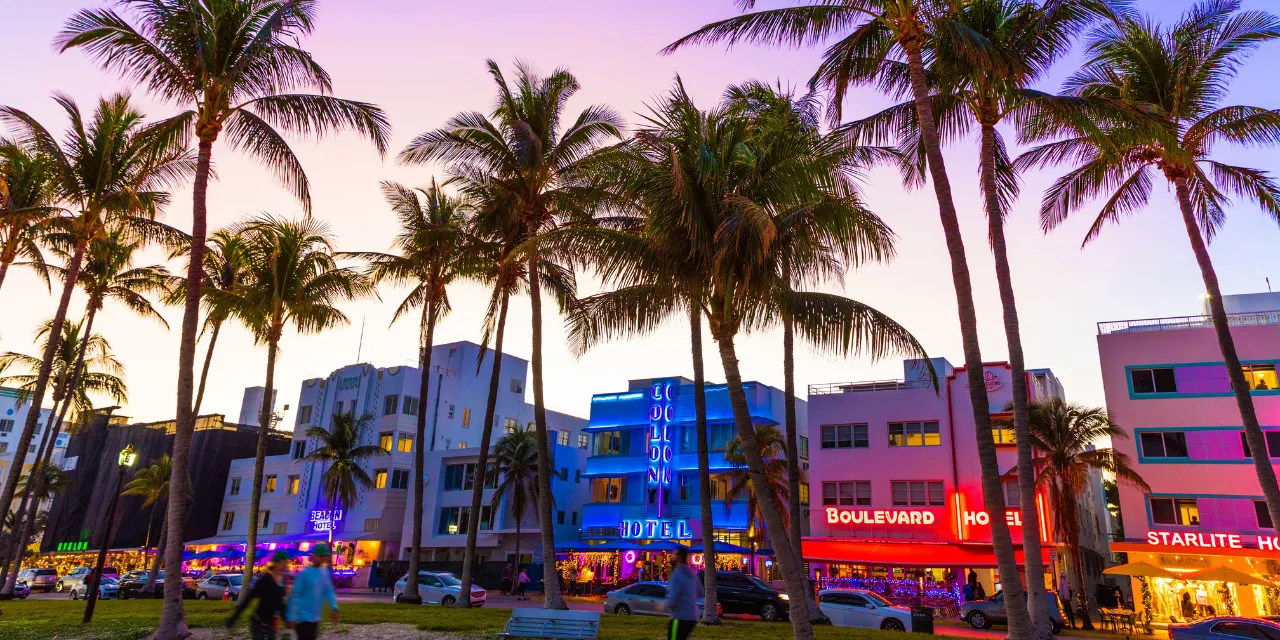
- Wynwood: The creative arts district, including the famous Wynwood Walls with graffiti-wall murals and galleries.
- Little Havana: The Cuban-influenced neighbourhood offering cultural immersion, live music, street life and local cuisine.
- Vizcaya Museum & Gardens: Historic estate with Italian-inspired gardens overlooking Biscayne Bay.
- Everglades (day-trips from Miami): While not strictly inside city proper, many visitors use Miami as a base for eco-tourism in the nearby Everglades National Park.
Beyond the neighbourhoods, the airport and port infrastructure also play a role: many cruise ship and international flight visitors arrive in Miami, stay briefly and explore the beaches and downtown areas.
The blend of urban, beach and nature allows a broad mix of sightseeing experiences.
Visiting patterns show that visitors often stay near the beach districts (Miami Beach) or downtown/Brickell zones and spend time exploring the arts districts, outdoor water-enabled attractions (such as boat tours) and cultural neighbourhoods.
Where Miami Visitors Stay and Eat: Top Hotels and Restaurants
Miami visitors gravitate toward beachfront hotels, stylish urban stays and diverse dining spots that showcase the city’s mix of luxury, culture, and coastal flavor.
Where Miami visitors usually stay
Accommodation in Miami-Dade is diverse: from ultra-luxury beachfront resorts in Miami Beach to boutique hotels in Wynwood and high-rise business hotels in Brickell.
Early 2025 data indicate strong hotel demand — for example during the first quarter average daily room rate (ADR) across the county was around $258 and occupancy around 82%.
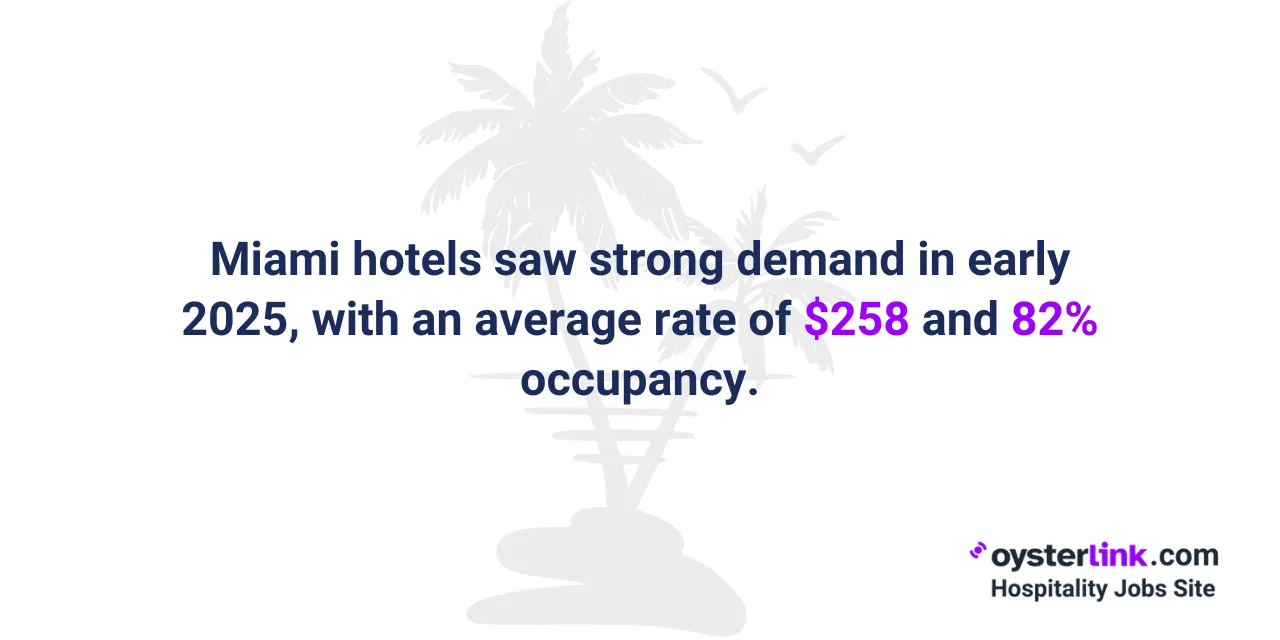
Miami consistently ranks among the top U.S. hotel markets: in 2024 it ranked 4th in occupancy among top 25 U.S. markets and 3rd in average daily rate.
Popular hotels are those in prime beach locations (Miami Beach), full-service resorts with conference and leisure amenities, as well as design-forward boutique hotels in arts districts.
Where Miami visitors usually eat
Food and dining are major draws for visitors. In Miami one finds high-end ocean-front restaurants, Latin-American and Cuban-influenced cuisine (especially in Little Havana and around Calle Ocho), fine dining in Brickell and Downtown, as well as beach café culture along the coastline.
According to listings on platforms like OpenTable and TripAdvisor, the most-booked restaurants for visitors lean toward beachfront dining, Latin-fusion cuisine, and high-profile spots with strong design and social-media appeal.
While we do not have a full publicly-released ranking of “most visited restaurant by tourists” for 2025, tourism commentary notes that six new entries from Miami were added to the 2025 Florida Michelin Guide — underscoring the destination’s food-tourism strength.
One of them is Torno Subito, a vibrant Italian restaurant known for its colorful, retro-chic design and playful take on fine dining.
From luxury resort dining to casual Cuban snacks, the diversity of the culinary scene supports Miami’s global-city tourist positioning.
See more on Miami’s hidden hospitality hotspots
Miami Tourism Visitor Numbers: Future Outlook
Looking beyond 2025, Miami-Dade’s tourism sector is expected to remain strong, supported by its record momentum from 2024.
However, global economic headwinds, slower international air travel growth and rising travel costs could temper expansion.
Major upcoming events, including sports championships and large conventions, are set to keep visitor demand steady, making infrastructure development and diversification into cultural and eco-tourism increasingly important.
Miami’s continued success will depend on its ability to balance growth with sustainability, local impact and authentic visitor experiences.
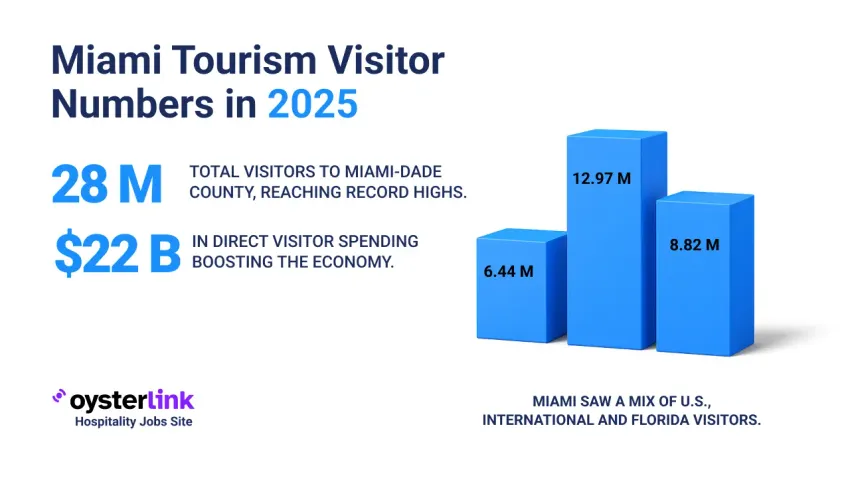









Loading comments...